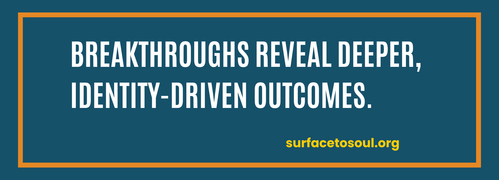Breakthrough Coaching (Part 3)

By Jim LaDoux
Breakthrough Coaching is about going beyond surface‐level coaching to evoke moments of insight (“lightbulb moments”) that change how clients see themselves, their stories, their possibilities. Reynolds blends neuroscience, emotional intelligence, reflective inquiry, and psychological safety to equip coaches to help clients disrupt old mental frames, clarify what they truly want, and commit to authentic action. The book is arranged in five parts:
Each Part has several chapters with tools, examples, cases, and exercises. Below I dive into key points, action items, and questions raised from Part 3.
- Part 1: How to Embody a Coaching Mindset
- Part 2: Maintaining a Client-Centered Focus
- Part 3: What Is Their Desired Outcome, Really?
- Part 4: Debugging the Operating System
- Part 5: Turning Insights into Commitments
Each Part has several chapters with tools, examples, cases, and exercises. Below I dive into key points, action items, and questions raised from Part 3.
KEY POINTS: Chapter 8 - Outcomes Are Dynamic, Not Static
Reynolds stresses that outcomes are living, shifting targets rather than fixed endpoints. Clients often begin coaching with surface-level goals shaped by external expectations. Through dialogue, deeper desires and identity-level aspirations emerge. Coaches should stay flexible, continually checking in to see if the articulated outcome still resonates with the client’s authentic needs and values.
Key Concepts:
Action Steps:
Discussion Questions:
Key Concepts:
- Initial goals are often provisional, not final.
- Breakthroughs reveal deeper, identity-driven outcomes.
- Coaches must normalize goal evolution as part of growth.
- Outcomes should be revisited, reframed, or refined throughout coaching.
- Clarity comes from dialogue, not from forcing specificity too soon.
Action Steps:
- Regularly ask: “Does this goal still feel right for you?”
- Use reflection to highlight shifts in client energy or focus.
- Reframe goals from “what I want to do” to “who I want to be.”
- Track language shifts across sessions as evidence of evolving outcomes.
- Celebrate when clients refine goals as a sign of growth, not failure.
Discussion Questions:
- Why do clients’ initial goals often change during coaching?
- How can you normalize evolving outcomes without creating confusion?
- What signals suggest a goal no longer resonates with the client?
- How does shifting from “doing” to “being” outcomes deepen coaching?
- What practices help you hold goals lightly but intentionally?
CHAPTER 9 - The Language of Desire
Breakthroughs emerge when clients articulate their desires in their own language. Reynolds highlights the power of listening for emotional cues, metaphors, and repeated phrases. Coaches can deepen insight by reflecting back the client’s words, which often carry unconscious longings. Asking clients to imagine, visualize, or describe what they want in vivid terms strengthens commitment and clarity.
Key Concepts:
Action Steps:
Discussion Questions:
Key Concepts:
- Language reveals the client’s true desires.
- Words carry emotional resonance and symbolic meaning.
- Metaphors can illuminate hidden truths.
- Coaches should reflect and amplify client language, not replace it.
- Desire must feel emotionally compelling to sustain change.
Action Steps:
- Capture clients’ exact words or metaphors and reflect them back.
- Ask: “What picture comes to mind when you say that?”
- Notice emotional energy shifts when clients speak certain words.
- Explore metaphors: “If this desire were a story, what would happen?”
- Encourage clients to write, draw, or journal about their desired future.
Discussion Questions:
- How does language reveal deeper client desires?
- What role do metaphors play in breakthrough coaching?
- How can reflecting clients’ words build ownership of outcomes?
- What techniques help clients describe their desires vividly?
- Why must outcomes be emotionally compelling to drive change?
BLOG COMMENTS
Please share your insights and comments related to this blog, particularly around the practice of mirroring the client's language, using metaphors, and noticing energy shifts when clients speak certain words.
Posted in 3 | Coaching Well Book Summaries
RECENT
Building a Year-Round Communications Calendar
September 23rd, 2025
What Research Reveals About Faith Maturity
September 23rd, 2025
Embracing a Generosity Mindset
September 20th, 2025
Breakthrough Coaching (Part 5)
September 14th, 2025
Breakthrough Coaching (Part 4)
September 14th, 2025
Breakthrough Coaching (Part 3)
September 14th, 2025
Breakthrough Coaching (Part 2)
September 14th, 2025
Breakthrough Coaching (Part 1)
September 14th, 2025
Sharing Generosity Stories Year-Round
August 22nd, 2025
Frame Giving Around Impact
August 16th, 2025
The Power of Generosity Stories
August 9th, 2025
The Pastor’s Role in Growing Generosity
July 30th, 2025
Foundations for Lifelong Faith
July 21st, 2025
Communicating Giving & Generosity
June 19th, 2025
Forming a Communications Team
June 18th, 2025
Measuring Church Members' Generosity
June 11th, 2025
Breakthrough Coaching
June 9th, 2025
Craft a compelling case for giving
May 21st, 2025
The Generosity Dashboard | Measuring What Matters Most
May 7th, 2025
Five Barriers to Giving
May 5th, 2025
ARCHIVE
2025
February
March
May
June
August
2024
January
February
March
April
September
October
2023
July
August
September
October
November
No Comments